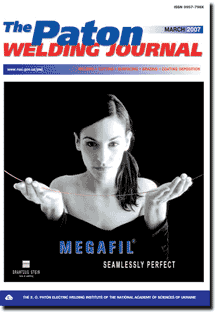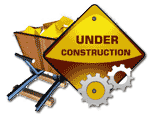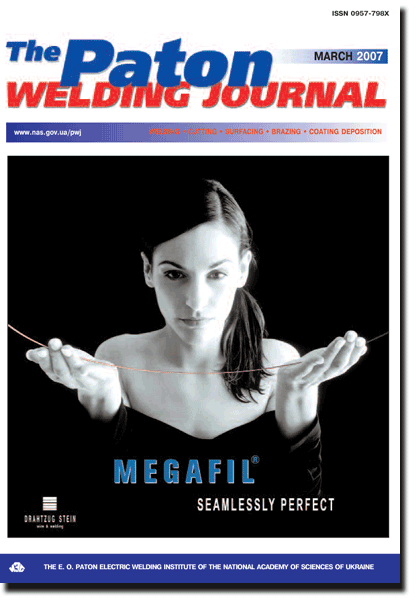

| SCIENTIFIC AND TECHNICAL | |||||||||||||||||||||||||||||||||||||||||||||||||||||||||||
| Kuchuk-Yatsenko S.I., Shvets Yu.V., Kavunichenko A.V., Shvets V.I., Taranenko S.D. and Proshchenko V.A. Influence of the width of stainless steel insert on performance of joints of railway frogs with rail ends | 2 | ||||||||||||||||||||||||||||||||||||||||||||||||||||||||||
Determined is the effect of the width of an insert of stainless steel 08Kh18N10T in pulsed flash-butt welding of steel 110G13L to M76 on the structural strength and wear resistance of the joints. It is shown that variation of insert width in the range from 10 to 40 mm hardly has any effect on performance of railway frogs.
| Chuvichilov V.A., Kuzmin S.V. and Lysak V.I. Energy conditions of explosion welding of layered composite materials | 6 |
Energy conditions of formation of joints in layered composite materials by explosion welding using stack and plane-parallel collision schemes are analysed. It is established that the stack cladding scheme is indicated in terms of cost and technology, starting from a certain thickness of target plate.
| Borisov Yu.S., Borisova A.L., Tunik A.Yu., Karpets M.V., Bobrik V.G., Vojnarovich S.G. and Kuzmich-Yanchuk E.K. Structure and properties of powders for production of bio-ceramic coatings by the plasma spraying method | 9 |
Structure and properties of domestic and foreign hydroxyapatite powders were studied by the method of differential thermal analysis. Phase transformations occurring in the powders during heating in neutral environment were investigated. Applicability of the powders for deposition of coatings on medical-application parts by microplasma spraying was determined.
| INDUSTRIAL | Mozzhukhin A.A. Design while inventing | 14 |
| Ryabtsev I.A., Kuskov Yu.M., Kondratiev I.A., Chernyak Ya.P. and Ryabtsev I.I. Consumables and energy-saving cladding technologies for reconditioning and manufacturing parts of machines and mechanisms | 18 |
The experience gained at the E.O. Paton Electric Welding Institute in development of consumables and technologies for reconditioning and manufacturing of parts of different machines and mechanisms by arc cladding is described. The focus is on power-saving consumables and technologies, allowing cladding of carbon steel parts to be performed without or with minimum preheating.
| Samotugin S.S. and Mazur V.A. Causes of defects formed in steels and alloys in surface hardening using high power density heat sources | 23 |
Causes of defects formed in surface layers of tool steels as a result of treatment of workpieces with high power density heat sources are considered. Peculiarities of formation of defects in laser and plasma treatment are noted. Methods for reducing the probability of formation of defects are suggested.
| Kasatkin O.G., Tsaryuk A.K., Skulsky V.Yu., Gavrik A.R., Moravetsky S.I., Kleshchevnikov I.D., Kopylov Yu.M. and Medvedev A.G. Method for improving local damage resistance of welded joints in NPP pipelines | 27 |
It is shown that the key factors causing corrosion cracking and fracture of composite welded joints in pipelines include chemical and structural heterogeneity of metal of a welded joint, formation of martensite and decarburised interlayers, stressed state and hydrogen-induced embrittlement of metal. The method is suggested for improving resistance of the welded joints to local corrosion damages.
| Poklyatsky A.G., Ishchenko A.Ya., Grinyuk A.A. and Yavorskaya M.R. Mechanical properties of 1441 aluminium alloy joints produces by different welding processes | 31 |
Comparative analysis has been performed of the strength and hardness in joints of 1441 aluminium alloy produced by fusion and friction stir welding. It is shown that the process of producing the joint by metal plasticization without its melting allows avoiding formation of defects characteristic for the aluminium-lithium alloys and improving the tensile strength of welded joints. It is found that the welds made by friction stir welding are non-symmetrical relative to their longitudinal axis. It is established that fracture of samples at static testing occurs from the side, from which the metal is driven by the working tip of the tool.
| NDT OF WELDED JOINTS | Troitsky V.A., Posypajko Yu.N., Shevchenko I.Ya., Karmazin V.I. and Kostenko G.E. Flaw detection in welded joints of a tank for liquid ammonia storage | 34 |
The paper presents the main kinds of diagnostics of welded joints at comprehensive technical examination of large-volume tanks for liquid ammonia storage with the purpose of extension of their service life, namely visual-optical inspection, including detection and evaluation of unevenness on the wall and bottom, more precise determination of the scope of application of other control techniques; NDT of welded joints and metal of the tank wall and bottom by ultrasonic, magnetic particle and liquid penetrant testing; determination of mechanical characteristics of the metal; metallographic examination and chemical analysis of the welded joint and base metal.
| BRIEF INFORMATION | Kovalchuk V.S., Knysh V.V., Poznyakov V.D. and Kasatkin S.B. Method for increasing cyclic and service life of welded steel structures | 37 |
A method for increasing fatigue resistance of welded joints of plate steel in initial state and after repair welding of remote fatigue cracks according to standard technology, using recommended consumables with subsequent facing of the welds by austenite-martensite wire Kh10N10 that induces favorable residual compressive stresses, is suggested. It is determined that cyclic life of welded joints in steel 09G2S, made and repaired according to the suggested technology, increases 5Д7 times in comparison with that achieved in case of using standard technology.
| Lankin Yu.N. Controller of metal pool level in ESW | 39 |
Structural scheme is presented and a system for the metal pool level control in ESW with application of the inductive sensor, containing a measuring fast-response transducer, is described. The system has passed laboratory tests that confirmed its design characteristics.
| News | 41 | Thesis for scientific degree | 45 | NEWS | Conference on Problems of Residual Service Life and Safe Operation of Structures, Constructions and Machines | 46 | To centenary of S.P. Korolyov's birth | 48 | Developed at PWI | 13 | 30 49 | |||||||||||||||
(You are viewing the simplified file contents)
The cost of subscription/purchase order journals or individual articles
| Journal/Currency | Annual Set | 1 issue printed |
1 issue |
one article |
| TPWJ/USD | 384 $ | 32 $ | 26 $ | 13 $ |
| TPWJ/EUR | 348 € | 29 € | 24 € | 12 € |
| TPWJ/UAH | 7200 UAH | 600 UAH | 600 UAH | 280 UAH |
| AS/UAH | 1800 UAH | 300 UAH | 300 UAH | 150 UAH |
| AS/USD | 192 $ | 32 $ | 26 $ | 13 $ |
| AS/EUR | 180 € | 30 € | 25 € | 12 € |
| SEM/UAH | 1200 UAH | 300 UAH | 300 UAH | 150 UAH |
| SEM/USD | 128 $ | 32 $ | 26 $ | 13 $ |
| SEM/EUR | 120 € | 30 € | 25 € | 12 € |
| TDNK/UAH | 1200 UAH | 300 UAH | 300 UAH | 150 UAH |
| TDNK/USD | 128 $ | 32 $ | 26 $ | 13 $ |
| TDNK/EUR | 120 € | 30 € | 25 € | 15 € |
AS = «Automatic Welding» - 6 issues per year;
TPWJ = «PATON WELDING JOURNAL» - 12 issues per year;
SEM = «Electrometallurgy Today» - 4 issues per year;
TDNK = «Technical Diagnostics and Non-Destructive Testing» - 4 issues per year.


